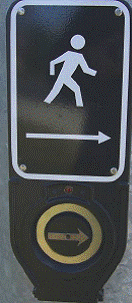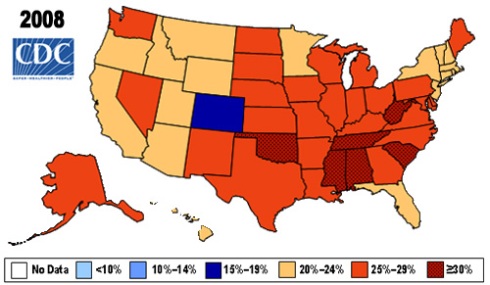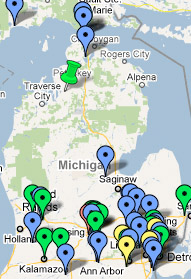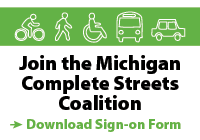You are currently browsing the monthly archive for July 2009.
 Join the coalition of supporters by signing the Michigan Complete Streets Petition today.
Join the coalition of supporters by signing the Michigan Complete Streets Petition today.
Petition Language:
I join the Michigan Complete Streets Coalition in support of statewide Complete Streets policies that require state and local road agencies to design and maintain roadways for all users, of all ages and abilities.
The streets of our cities and towns are an important part of the livability of our communities. They ought to be designed for everyone, whether young or old, motorist or bicyclist, walker or wheelchair user, bus rider or shopkeeper. It is time that our state’s transportation planning agencies — including the Michigan Department of Transportation, metropolitan planning organizations, local road agencies, and local governments — adopt Complete Streets policies and build a safer, cleaner, more sustainable transportation system.
Sign the petition here
Webinar scheduled for July 28th from 9am-12pm about the federal economic stimulus funds that are flowing through the US Department of Energy for energy efficiency dollars. There are several energy efficiency sectors eligible to receive the money, and one of them is transportation. A portion of these dollars went to already entitled community block grant cities, but another portion will be awarded to non-entitlement communities who compete for these funds. It has been presented in the training sessions that BIKE PATH FEASIBLITY STUDIES DO QUALIFY. There is one more training opportunity left. You can sign up on the Michigan.gov website at http://www.michigan.gov/dleg/0,1607,-154-25676-217150-,00.html
PowerPoint dismisses liability concerns for constructing roadways that accommodate pedestrians and bicyclists
A must view PowerPoint for all Michigan road agencies, planners, engineers and politicians. Written by Ronald W. Emery (Transportation Division Dept. of Attorney General), Josh DeBruyn (Bicycle and Pedestrian Coordinator - MDOT) and Deirdre Thompson (Bicycle and Pedestrian Safety Engineer - MDOT), this PowerPoint demonstrates through case law that NO liability risk exists for accommodating nonmotorized facilities users through bike lanes, road diets, mid-block crossings or signing rural roads/shoulders as bike routes.
Download Presentation: Ped Bike Safety and Liability
Questions on this presentation can be directed to:
Josh DeBruyn, AICP
Bicycle and Pedestrian Coordinator
Bureau of Transportation Planning
Michigan Department of Transportation
517-335-2918
Healthy Kids, Healthy Michigan (HKHM) Complete Streets Task Force distributes Complete Streets Resolution to all Michigan Legislators.
Download the HKHM Complete Streets Resolution.
Background on HKHM:
In 2007, Governor Granholm received a one-year grant award from the National Governors Association through the Healthy Kids, Healthy America program. This program was designed to provide the nation’s governors with the opportunity and means to make progress in addressing childhood obesity in schools and communities in their state. Governor Granholm’s project, Healthy Kids, Healthy Michigan, worked with executive-level decision-makers from government, public and private sectors, school districts, health care and non-profit organizations to create a multi-year strategic policy agenda to reduce childhood obesity in Michigan.
Over the year-long Healthy Kids, Healthy Michigan project, more than 100 organizations collaborated to explore and prioritize policy options to confront childhood obesity. A five-year strategic plan has been developed and a set of first-year priorities identified.

Push button integrated Accessible Pedestrian Signals (APS).
According to the June 25th edition of the U.S, Access Board’s Access Currents, “Product innovations and improved technologies have enhanced the accessibility of pedestrian signals now on the market. Low-volume audible signals and tactile features have been incorporated into the design of products to provide access to pedestrians with vision impairments more effectively. The industry standard, the Manual on Uniform Traffic Control Devices, includes specifications for accessible pedestrian signals which derive from recommendations developed by a former Board advisory panel, the Public Rights-of-Way Access Advisory Committee.
“The Board has released new guidance on installing these types of pedestrian signals. ‘Common Problems Arising in the Installation of Accessible Pedestrian Signals’ reviews access features of available products, including locator tones, audible and vibrotactile indicators of crossing cycles, and signal volume and explains important considerations in the placement and orientation of signal devices. The low-volume indicators of current products make proper installation essential in order for signals to be effective. The bulletin uses case studies and field evaluations to illustrate various installation ‘do’s and don’ts’ in relation to common site conditions and factors.”
The publication, which includes an installation checklist and other resources on accessible public rights-of-way are available on the Board’s website at:
http://tinyurl.com/ncogn4
New mobility report says peak-time travelers in the Detroit area lose an average of 52 hours a year and waste 34 gallons of fuel because of traffic congestion and transit delays.
Read the Detroit Free Press Article
Read the report at http://mobility.tamu.edu/ums
Complete Streets reduce congestion. Providing more travel options relieves some of the burden on our overcrowded roadways – everyone can get where they want to go more quickly and efficiently. Michiganders could face less traffic congestion and cut their transportation costs if statewide Complete Streets policies were implemented. The average American who lives in an area that’s walkable and has transit spends only 9% of their income on transportation, while a person living in an area that requires driving spends more than 25%. In addition, Complete Streets are cost effective because when cities and towns build streets correctly the first time, they reduce congestion, pollution, and local contributions to the global warming problem by providing several travel options.
New Report Finds Michigan Has 9th Highest Percent of Obese Adults and 26th Highest Percent of Obese and Overweight Children in the U.S. studyTrust for America’s Health, a health advocacy organization, recently released nationwide obesity statistics and found Michigan to be ranked the ninth most obese in America. With 28.8 percent of the Michigan population obese, including more than one-third of 55 to 64-year-olds, Michigan is up from last year’s tenth-place ranking.
Incomplete streets restrict physical activity
When streets are designed only for cars, they deny people the opportunity to choose more active ways to get around, such as walking and biking. Even where sidewalks exist, large intersections and speeding traffic may make walking unpleasant or even unsafe - discouraging any non-motorized travel.
Read the rest of this entry »

Steps and a non ADA compliant curb cut in Flint, Michigan make this sidewalk impossible to use by anyone requiring a mobility device. Photo by Barbara McCann
Please join the Michigan Complete Streets Flickr group and upload your photos and videos of both complete and incomplete streets throughout Michigan.
You are encouraged to add comments that explain the good, bad and ugly of Michigan roadways. Please identify the locations of the photos as specifically as possible in your comments and add geotags to your images so the group can view images on a GIS-based map. (for help see: www.flickr.com/help/screencasts/vol1/)
This site will serve as a database of information to be used in local, statewide and national policy efforts to complete our streets to make them safe for all users.
So next time you are out and about, make sure to grab your camera to help build up our Complete Streets database.
Also make sure to check out other great examples of complete and incomplete streets throughout the country at the National Complete Streets Flickr site: www.flickr.com/photos/completestreets/

















